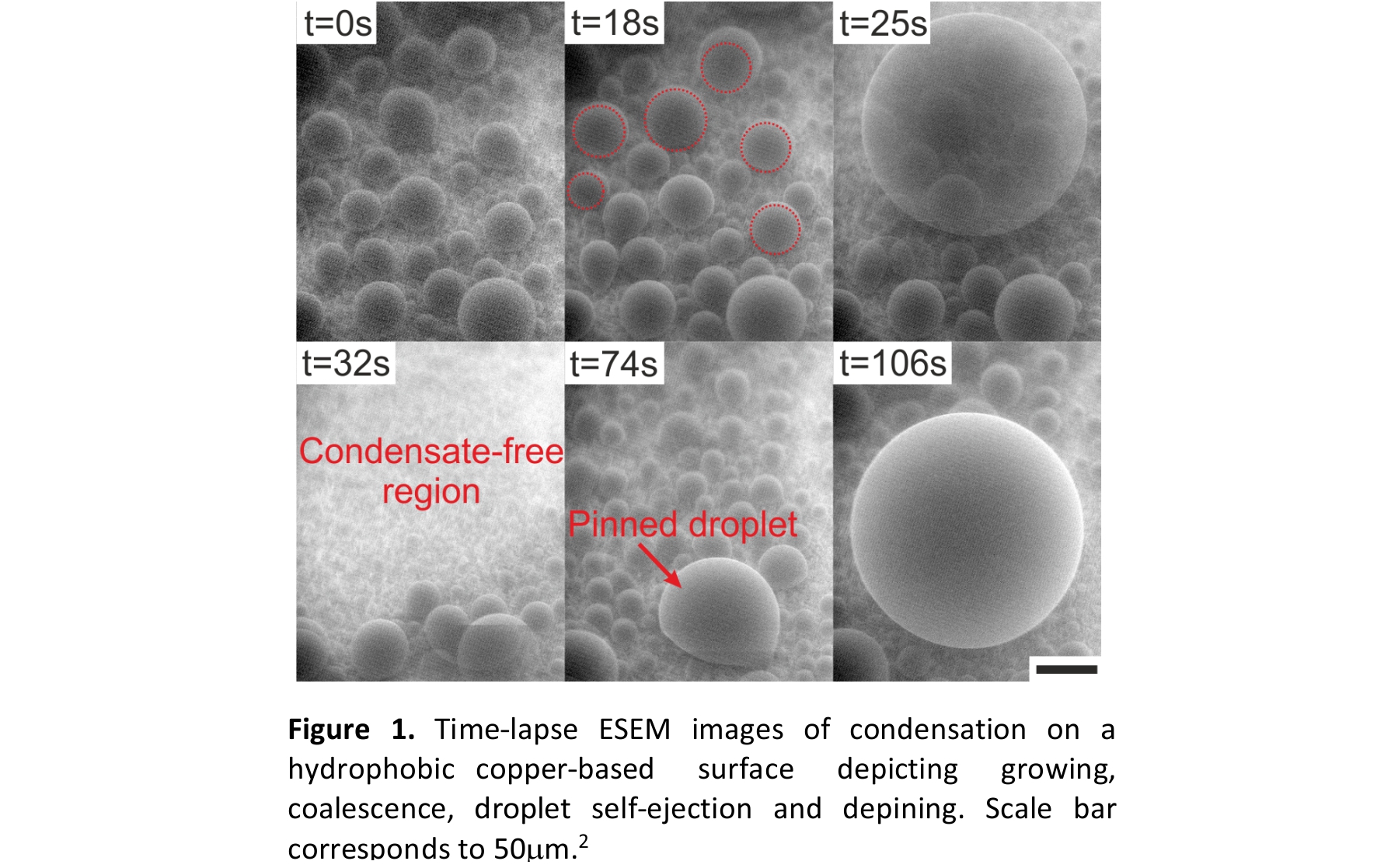Surface Engineering and Interfacial Processes
Enhancement of production process efficiency plays a key role in energy management. We explore ways to optimize and develop innovative process technologies to reduce industrial energy consumption. In this respect, capillarity and interfacial phase change processes constitute a novel approach towards enhancing the performance of integral parts of industrial applications e.g. heat exchangers, tubes, porous media and high voltage conductors.
We mainly focus on the following topics:
Condensation heat transfer enhancement (in collaboration with LTNT, D-MAVT, ETH Zurich)
A significant body of research effort is being devoted to the design of novel metal surfaces to achieve1 and maintain dropwise condensation (DWC) due to its much higher heat transfer efficiency compared to filmwise condensation (FWC).2 However, sustenance of DWC mode for long operational times using materials that are application relevant and durable under quiescent vapor or harsh vapor flow (flow condensation) conditions, despite its importance, has remained elusive so far. We explore rational approaches towards the design, fabrication and characterization of surfaces that sustain DWC with vapor flow or quiescent vapor conditions over these surfaces aiming at overcoming mentioned thresholds in heat transfer and durability. Our associated project is supported by the Commission for Technology and Innovation (CTI) under the Swiss Competence Centers for Energy Research (SCCER) Efficiency of Industrial Processes (EIP) program and Swiss National Science Foundation (SNSF) Grant.
Suppression of Corona Effect on HVDC Conductors (in collaboration with HVL, D-ITET, ETH Zurich)
High Voltage overhead lines are currently an integral part of the electrical energy transport system. A key aspect of their environmental performance is related to the so-called corona effects (Figure 2).3,4 Corona is a partial electric discharge caused by high electric fields on the conductor surface and is the cause of noise, radio interference and, in the case of High Voltage Direct Current (HVDC), also ion currents at ground level. Water drops are one of the primary determinant of how intensive these effects are (a perfectly dry conductor should not produce any corona). Therefore, wetting behavior of the conductor’s surface is important. Our associated project is partially supported by an ETH Career Seed Grant.
Drag reduction and antifouling performance of cylindrical mini tubes
When a water droplet comes in contact with a superhydrophobic surface, air cushion is entrapped underneath the droplet resulting in the reduction of the solid-water contact surface area and low pinning forces (in case the droplet moves) since contact angle hysteresis θa-θr is low i.e. <10o (Figure 3). Therefore, for the case of water flowing in a tube the surface of which exhibits superhydrophobic behavior, air entrapment between liquid and solid introduces slip condition on the surface resulting in reduced wall shear stresses. Furthermore, self-cleaning behavior due to superhydrophobicity enhances antifouling performance which in turn prevents drag increase attributed to potential decrease of the tube diameter.5 Consequently, drag reduction can be achieved and sustained leading to less pumping power for water transportation through tubes,6 fulfilling the need for adopting energy saving strategies in industrial processes.
References
- Sharma, C. S.; Combe, J.; Giger, M.; Emmerich, T.; Poulikakos, D. Growth Rates and Spontaneous Navigation of Condensate Droplets Through Randomly Structured Textures. ACS Nano 2017.
- Stamatopoulos, C.; Sharma, C. S.; Suter, R.; Poulikakos, D.; Rudolf von Rohr, P. Surface Engineering for Heat Transfer Enhancement of Convective Dropwise Condensation. In 9th World Conference on Experimental Heat Transfer, Fluid Mechanics and Thermodynamics; Iguazu Falls, 2017.
- Schultz, T.; Pfeiffer, M.; Franck, C. M. Optical Investigation Methods for Determining the Impact of Rain Drops on HVDC Corona. J. Electrostat. 2015, 77, 13–20.
- Pfeiffer, M.; Franck, C. M. Impact of Conductor Surface Type and Rain Intensity on HVDC Corona Losses. IEEE Trans. Power Deliv. 2015, 30, 2284–2292.
- Bixler, G. D.; Bhushan, B. Bioinspired Micro/nanostructured Surfaces for Oil Drag Reduction in Closed Channel Flow. Soft Matter 2013, 1620–1635.
- Kavalenka, M. N.; Vüllers, F.; Lischker, S.; Zeiger, C.; Hopf, A.; Röhrig, M.; Rapp, B. E.; Worgull, M.; Hölscher, H. Bioinspired Air-Retaining Nanofur for Drag Reduction. ACS Appl. Mater. Interfaces 2015, 7, 10651–10655.

Supported by:



